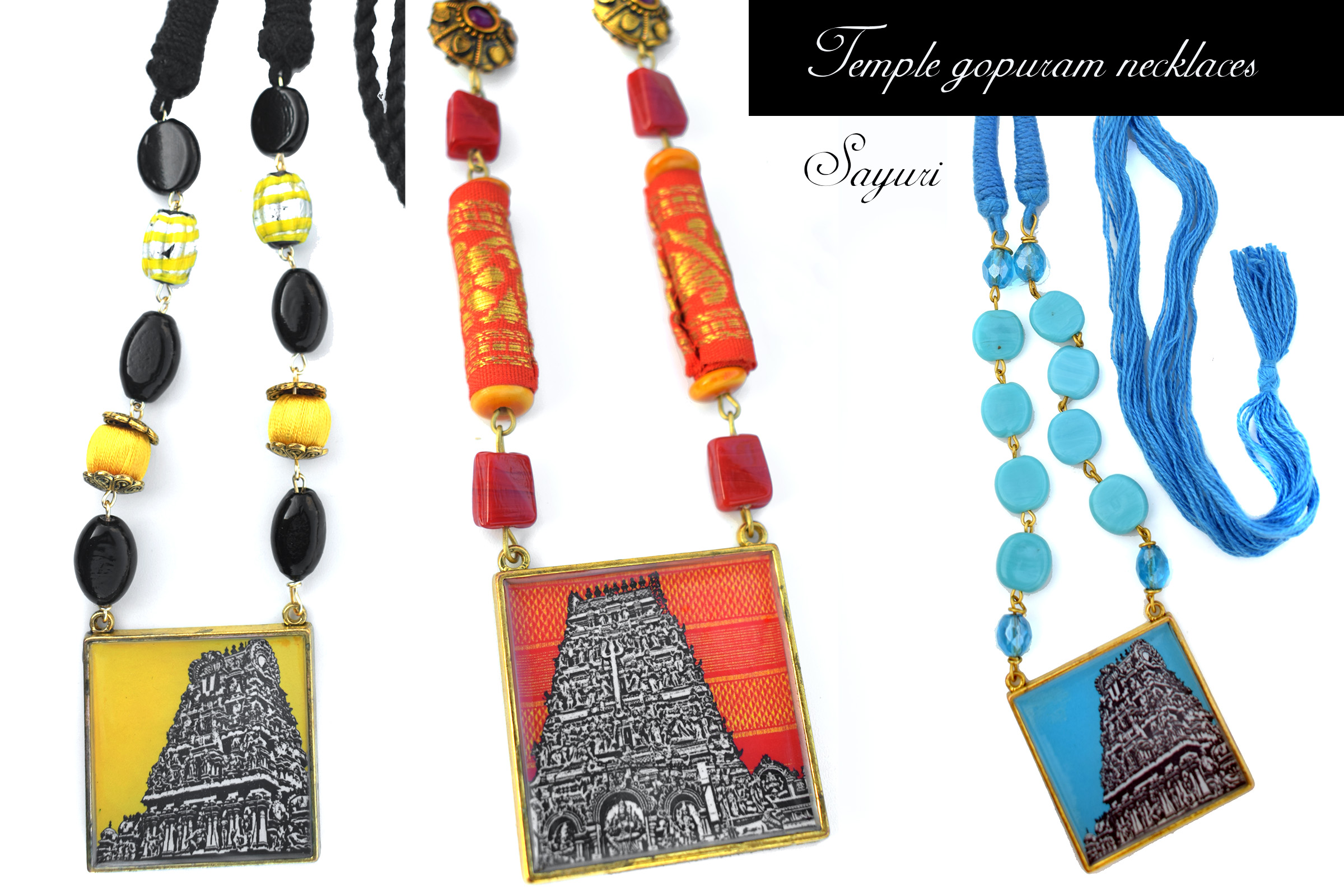The word Marabu has many meanings; legacy, customs, practices of a culture. The term culture (in a western sense) is made up of the entanglement of features of language, art, religion, food, dress, music in varying proportions. Therefore, these category were those that I kept in mind while working on Marabu jewellery as it was based on Tamil Culture. Since this is the first of many posts detailing the collection, I will begin with religious identity that I worked with in the form of Temple gopuram necklaces.
There maybe be several identities of religions, even Hinduism. Many of them are abstract and difficult to articulate. Material identity is easier to decode since it is tangible. Material identity includes the forms of deities, the way they are dressed, the architecture of the places of worship and so on. In my post on why Hindu Gods wear jewellery, I spoke about the theory of adornment in Hinduism. However, in Marabu I did not want to delve into spiritual or religious practices and wanted to stay with a more immediate identity. Thus I chose temple gopurams to work with.
 Architectural identity of Temple Gopurams
Architectural identity of Temple Gopurams
Gopurams or shikaras are tall pyramidal structures at the entrances of temples. They may even be constructed on the top of the many shrine. Temple architecture various from state to state in India and so do the gopurams. In Tamil Nadu, they are typically one of two kinds. Either a plain stone archway or a heavily ornamented colourful arch. The latter is filled with statutes of Gods, Goddesses, demi gods, keeps, mounts, animals and humans and painted with lots of colour. Older gopurams were constructed out of suthai – a mixture of limestone, sand and water while cement is used in newer constructions. The painting is not simply ornamental but protects the underlying structure from natural damage.

Necklaces inspired by South Indian temples
The colourful gopurams strike the fancy of tourists and locals alike. There is a strong visual identity, one that is easier to convert to jewellery. But I do not use colourful gopuram images in my jewellery. I convert them into black and white illustrations and play with colour using beads. I did this twice e before in my thematic collections such as Patinam and Parampare. Check out temples of Karnataka as jewellery and Chennai Temple necklaces to see my past work on similar lines.
Chennai Temple gopuram necklaces
In this post, I want to show three necklaces based on two temple gopurams. Both the temples – The Kalikaambal temple and Triplicane Parthasarathy temple are located in Chennai. The first two are available for sale and the blue one is sold.

Kalikaambal Temple necklace
The Kalikaambal Temple is a 17th century temple dedicated to Goddess Kamakshi. The temple is known for its divine and powerful feminine energy. Blessings are offered here in the form of kumkum, red powder used to make a mark on the forehead. Getting this is considered auspicious. My inspiration for this necklace was the kumkum, silk sarees which are used to drape the deity and the temple gopuram itself. The pendant is a 45mm square with a digital illustration on the temple gopuram on a cotton saree pallu. The beads are glass, fabric and metal. The Kalikaambal temple necklace is available for sale.

Parthasarathy temple at Triplicane as necklaces
The next two are inspired by the Parthasarthy temple – which is a Vishnu temple at Triplicane. The word Triplicane is an angelised version of Tiruvallikeni meaning a divine tank full of lilies. There is a large temple tank opposite the temple so no prizes for guessing the use of colour blue in the necklace. When I was a student, I have spent days at this temple and its surrounding area for my field studies project in 2003. So whenever I think of this area I am reminded of warm yellowy afternoons I have spent there sketching voluminous pillars.

Those are the three Temple gopuram necklaces in Marabu. Now some of you may wonder why I limit myself to Hindu temples when Islam, Christianity, Buddhism, Jainism are also followed by Tamil people. In the process of producing, preserving and propagating a religious cultural identity I think its best to stick to what I know. I have done custom jewellery with images of Buddha and illustrations of churches in the past and I am open to doing more in the future.
Please do tell me what you think about the collection. In case you haven’t seen it yet, check out the Marabu jewellery here.
I hope you found it interesting
Cheers



 Architectural identity of Temple Gopurams
Architectural identity of Temple Gopurams
What do you think?